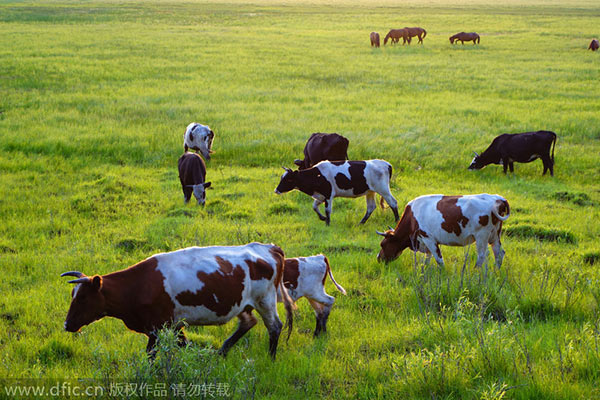 |
|
Cows in the Inner Mongolia autonomous region, China on Sept 14, 2014. [Photo/IC] |
Crated up and loaded onto the main deck of a Boeing Co 747 cargo plane by hydraulic lift, the 150 beasts were on Australia's first live cattle flight to central China. Destination: The abattoir.
The flights are possible, and profitable, because of China's soaring demand for fresh beef and regulations that require imported live animals to be slaughtered close to their point of entry. That means that if you want to sell fresh steaks to inland cities, like Chongqing, you need a big plane.
"Air freight does provide the opportunity to get cattle into inland areas," said Cameron Hall, general manager for live exports at Elders Ltd, the Adelaide, Australia-based rural-services company that managed the first flight on Oct 20. "If you're sending them in by sea, then that limits you very much to the coastal areas."
The prize is clear. China will eat an extra 2.2 million metric tons of beef a year by 2025, according to Rabobank-enough to make 19 billion quarter-pounders. The demand pushed up Chinese prices fourfold since 2000 to about $10 a kilogram in June-making them among the most expensive in the world.
So, just months after the two countries sealed a free trade agreement covering everything from cows to coal, Australia-based livestock agents and exporters have chartered aircraft, sought out quarantine sites and designed bigger animal transport ships.
"It is a massive opportunity," said David Williams, managing director of Melbourne-based advisory firm Kidder Williams Ltd.
Part of the reason for growth is a change in diet. For centuries, China's favored meat has been pork, partly because backyard pigs not only supplied meat, but were good at turning waste into manure. Until recently, beef-once known as "millionaire's meat"-was very rare.
Hog meat now accounts for less than 60 percent of total protein demand in China compared with more than 90 percent three decades ago, according to New Hope Group Co, the nation's biggest maker of animal feed.
That means the rise of a $60 billion-a-year beef market. And in China, almost every part of the animal is used.
"The offal and the bones and all that product is used in a manner that is even beyond our imagination," said Scot Braithwaite, chief operating officer of livestock exporter Wellard Group. "The bones get one use, to be boiled and used for soups, and they dry it out and use it again as a basis for Chinese medicine."
Consumers in China will pay more than in other markets for top-grade beef when they're certain it's been reared in Australia, said Braithwaite.
On the inaugural flight of animals for slaughter, Angus and Hereford cattle were packed onto the aircraft's main deck. Upstairs, there was room for a few human escorts.
The cows were given limited food and water before the trip to reduce the mess they'd make during shipment. What they did excrete during the 13-hour flight was soaked up by absorbent mats, which were destroyed at the destination, along with the crates.
Once in China, the cows were lifted onto trucks with a crane, to be taken to the quarantine area. That site must be within 90 kilometers of the arrival port, according to Hall.
